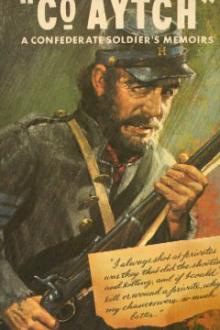The History Of Education by Ellwood P. Cubberley (little red riding hood read aloud .txt) 📕

- Author: Ellwood P. Cubberley
- Performer: -
Book online «The History Of Education by Ellwood P. Cubberley (little red riding hood read aloud .txt) 📕». Author Ellwood P. Cubberley
The kindergarten will always do best among self-governing peoples, and seldom meets with favor from autocratic power.
[17] “In the best English Infant Schools a profound revolution has taken place in recent years. Formal lessons in the 3 Rs have disappeared, and the whole of the training of the little ones has been based on the principles of the kindergarten as enunciated by Froebel. Much of the old routine still remains; nevertheless there is no part of the English educational system so brimful of real promise as the work that is now being done in the best Infant Schools.” (Hughes, R. E., The Making of Citizens (1902), p. 40.)
[18] In France, the Infant School or kindergarten is known as the Maternal School. Pupils are received at two years of age, and carried along until six. In the lower division the school is largely in the nature of a day nursery, but in the upper division many of the features of the kindergarten are found.
[19] Since Froebel’s day we have learned much about children that was then unknown, especially as to the muscular and nervous organization and development of children, and with this new knowledge the tendency has been to enlarge the “gifts” and change their nature, to introduce new “occupations,” elaborate the kindergarten program of daily exercises, and to give the kindergarten more of an out-of-door character. Especially has the work of Dewey (p. 780) and the child-study specialists been important in modifying kindergarten procedure.
[20] By 1880 some 300 kindergartens and 10 kindergarten training-schools, mostly private undertakings, had been opened in the cities of thirty of the States of the Union. By 1890 philanthropic kindergarten associations to provide and support kindergartens had been organized in most of the larger cities, and after that date cities rapidly began to adopt the kindergarten as a part of the public-school system, and thus add, at the bottom, one more rung to the American educational ladder. To-day there are approximately 9000 public and 1500 private kindergartens in the cities of the United States, and training in kindergarten principles and practices is now given by many of the state normal schools.
[21] In 1918, for example, according to a recent Report to the Zionist Board of Education in the United States, there were over 5300 children in kindergartens in Palestine, 125 kindergarten teachers there, and a College for Kindergarten Teachers had been organized in the Holy Land to train additional teachers.
[22] The Saint Louis Manual Training High School, founded in 1880 in connection with Washington University, first gave expression to this new form of education, and formed a type for the organization of such schools elsewhere. Privately supported schools of this type were organized in Chicago, Toledo, Cincinnati, and Cleveland before 1886, and the first public manual-training high schools were established in Baltimore in 1884, Philadelphia in 1885, and Omaha in 1886. The shop-work, based for long on the “Russian system,” included wood-turning, joinery, pattern-making, forging, foundry and machine work. The first high school to provide sewing, cooking, dressmaking, and millinery for girls was the one at Toledo, established in 1886, though private classes had been organized earlier in a number of cities.
[23] A few of the earlier adaptations of the idea may be given. In 1882
Montclair, New Jersey, introduced manual training into its elementary schools, and in 1885 the State of New Jersey first offered state aid to induce the extension of the idea. In 1885 Philadelphia added cooking and sewing to its elementary schools, having done so in the girls’ high school five years earlier. In 1888 the City of New York added drawing, sewing, cooking, and woodworking to its elementary-school course of study.
[24] In 1802 Napoleon provided for instruction in natural history, astronomy, chemistry, physics, and mineralogy in the scientific course of the lyc�es, and in 1814 enlarged this instruction. He also established numerous technical and military schools, with instruction based on mathematics and science.
[25] The Royal Commissioners which reported on the condition of the University of Oxford, in 1850, said: “It is generally acknowledged that both Oxford and the country at large suffer greatly from the absence of a body of learned men devoting their lives to the cultivation of science, and to the direction of academical education. The fact that so few books of profound research emanate from the University of Oxford materially impairs its character as a seat of learning, and consequently its hold on the respect of the nation.”
[26] Book instruction in the new sciences goes back, in the universities of most lands, to the late eighteenth century, but laboratory instruction is a much more recent development. Chemistry was the first science to develop, being the mother of science instruction, and probably the first chemical laboratory in the world to be opened to students was that of Liebig at Giessen, in 1826. The first American university to provide laboratory instruction in chemistry was Harvard, in 1846. The instruction in science in most of the universities, up to at least 1850, was book instruction. (See schedule of studies for University of Michigan, R. 331.) The first American university to be founded on the German model was Johns Hopkins, in 1876.
[27] By Charles Mayo and his sister, who opened a private Pestalozzian school, about 1825. Miss Mayo published her Lessons on Objects, explaining the method, and this became very popular in England after about 1830. Both the Mayos were prominent in the Infant-School movement, which adopted a formalized type of Pestalozzian procedure.
[28] In 1871 Dr. William T. Harris, then Superintendent of City Schools in Saint Louis, published a well-organized course for the orderly study of the different sciences. This attracted wide attention, and was in time substituted for the scattered lessons on objects which had preceded it.
This in turn has largely given way, in the lower grades, to nature study.
[29] At the time of Professor Bache’s visit, in 1838, the instruction included Latin, French, English, German, history, religion, music, drawing, mathematics, natural history, physics, chemistry, and geography.
[30] Scientific instruction in the Lyc�es was not in favor in France after 1815, and in 1840 it was materially reduced, on the ground that it was injuring classical studies.
[31] Astronomy, botany, chemistry, and natural philosophy had been prominent studies in the American academies. Between about 1825 and 1840
was the great period of their introduction. The first American high school (Boston, 1821) provided for instruction in geography, navigation and surveying, astronomy, and natural philosophy. By 1850 the rising high schools were incorporating scientific studies quite generally. The instruction was still textbook instruction, but some lecture-table demonstrations had begun to be common.
[32] The Oneida School of Science and Industry, the Genesee Manual-Labor School, the Aurora Manual-Labor Seminary, and the Rensselaer School, all founded in the State of New York, between 1825 and 1830, were among the most important of these early institutions.
[33] Spencer’s classification of life activities and needs, in the order of their importance, was (R. 362):
1 Those ministering directly to self-preservation.
2. Those which secure for one the necessities of life, and hence minister indirectly to self-preservation.
3. Those which have for their end the rearing and discipline of offspring.
4. Those involved in the maintenance of proper social and political relations.
5. Those which fill up the leisure part of life, and are devoted to the gratification of tastes and feelings.
[34] All were republished in book form, in 1861, under the title of Education; Intellectual, Moral, and Physical. The volume contains four essays: What Knowledge is of Most Worth?; Intellectual Education; Moral Education; and Physical Education. The first essay served as an introduction to the other three.
[35] “A Liberal Education,” in his Science and Education. p. 86.
[36] For many years head of the School of Education at the University of Chicago, but more recently Professor of Philosophy at Columbia University, New York City.
[37] Dewey, John, in Elementary School Record, p. 142.
[38] Described in The Elementary School Record, a series of nine monographs, making a volume of 241 pages. University of Chicago Press, 1900.
[39] A very good example of this is to be found in the work of Colonel Francis W. Parker (1837-1902) in the United States. It was he who introduced Germanized Pestalozzian-Ritter methods of teaching geography; he who strongly advocated the Herbartian plan for concentration of instruction about a central core, which he worked out for geography; he who insisted so strongly on the Froebelian principle of self-expression as the best way to develop the thinking process; he who advocated science instruction in the schools; and he who saw educational problems so clearly from the standpoint of the child that he, and the pupils he trained, did much to bring about the reorganization in elementary education which was worked out in the United States between about 1875 and 1900.
[1] For long the knowledge-conception dominated instruction, it being firmly believed by the advocates of schools that knowledge and virtue were somewhat synonymous terms.
[2] It is to democratic England and the United States, and to the English self-governing dominions, that the greatest flood of emigrants from less advanced civilizations have gone. South America has also experienced a large recent immigration, but this has been mainly of peoples from the Latin races, and hence easier of assimilation.
[3] See a good article on this development by I. L. Kandel, in the Educational Review for November, 1919, entitled “The Junior High School in European Systems.”
[4] Paris, for example, has become the greatest university in Europe, exceeding Berlin (1914) in students by approximately 25 per cent and in expenditures 40 per cent.
[5] “The rise of these great universities is the most epoch-making feature of our American civilization, and they are to become more and more the leaders and the makers of our civilization. They are of the people. When a state university has gained solid ground, it means that the people of a whole state have turned their faces toward the light; it means that the whole system of state schools has been welded into an effective agent for civilization. Those who direct the purposes of these great enterprises of democracy cannot be too often reminded that the highest function of a university is to furnish standards for a democracy.” (Pritchett, Henry S., in Atlantic Monthly.)
[6] The gifts and bequests for colleges and universities in the United States, from 1871 to 1916, totaled $647,536,608, and by 1920 probably have reached $750,000,000.
[7] The oldest was Charlottenburg (1799), Darmstadt (1822), Carlsruhe (1825), Munich (1827), Dresden (1828), Nuremberg (1829), Stuttgart (1829), Cassel (1830), Hanover (1831), Augsburg (1833), and Brunswick (1835). A similar school, which later developed into a technical university, was founded at Prague, in Bohemia, in 1806.
[8] The German technical training “produces an engineer who is not only older in years, but also more mature in experience and in judgment than the average graduate of an engineering college in America. Whether or not it would be wise to adopt—so far as that would be possible—German methods in the schools and colleges of the United States, it must nevertheless be recognized that those methods have given Germany a leadership in applied science and in industry which she will keep unless the educational authorities of other nations find some way of producing men of like





Comments (0)